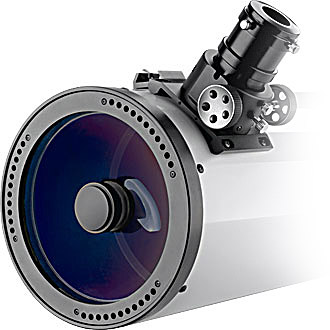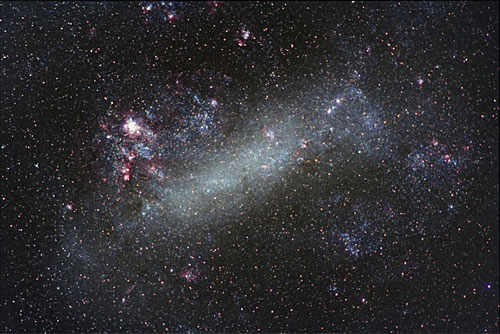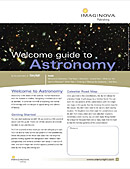 |
||||||||||||||||||||||||||||||||||||||||||||||||||||||||||||||||||||||||||||||||||||||||||||
|
If you have trouble viewing this newsletter, click here. Welcome again to our monthly newsletter with features on exciting celestial events, product reviews, tips & tricks, and a monthly sky calendar. We hope you enjoy it!
Many years ago I purchased an Orion Argonaut 152mm Maksutov-Newtonian, which proved to be one of the finest telescopes I have ever owned. When Orion® announced recently that they would be producing a 190mm Maksutov-Newtonian, I was very excited. So what on Earth is a Maksutov-Newtonian? Dmitri Dmitrievich Maksutov was a brilliant Russian optical designer, most famous for his discovery that a thick and deeply curved meniscus lens could be used to provide corrections similar to a Schmidt corrector plate, but be much easier and more accurate to fabricate. This corrector plate is most commonly found in Maksutov-Cassegrain telescopes, such as the legendary Questar. A similar corrector plate can be used in other designs, notably the Maksutov-Newtonian. This resembles a normal Newtonian reflector, but with the addition of a Maksutov meniscus at the front of the telescope, which serves a second function is supporting the Newtonian secondary mirror, reflecting the light from the primary to the eyepiece or camera on the side of the tube. This eliminates the usual spider secondary support, which in turn eliminates diffraction spikes from the images. The result is a wide, flat, well-corrected field of view. This Mak-Newt design was exploited by Canadian optician Peter Ceravolo to produce some of the finest optical systems ever available to the amateur astronomer. As I unpacked this telescope, it was clear that this is a serious instrument built to very high standards. The front corrector has a high “coolness factor” with its deep curvature and beautiful optical coating.
There are three sets of ventilation holes in the bezel around the corrector plate which, along with a cooling port behind the primary mirror, provide adequate cooling for the large pieces of glass in this telescope. The port behind the primary can be fitted with a fan to enhance this cooling. This scope is designed primarily as an imaging scope, with its image plane well outside the optical tube allowing enough back focus for most film and CCD cameras. Visual observers like myself are not forgotten, as the telescope comes with an extension tube so that most normal eyepieces can reach focus. There is also an adapter to fit 1.25” eyepieces and accessories to the 2” Crayford focuser. The telescope is sold as an “OTA”: Optical Tube Assembly. This “bare bones” condition makes sense with a specialized instrument like this, because most purchasers will already have most of the accessories they will need, or will want the freedom to purchase their own choice of accessories. These will include, first and foremost, a seriously heavy-duty equatorial mount. For test purposes, I mounted mine on a Vixen GP-DX mount, which required no less than three counterweights to balance the 22-pound weight of the tube assembly. I also received tube rings and a dovetail plate in order to mount the tube to the Vixen mount. The scope has a standard Vixen/Orion® finder shoe. As a visual observer, I was looking forward to seeing how the optics on this scope would compare with the superb optics on my Orion® Argonaut. I was pleased to discover that its optics were outstanding. Views of Jupiter and the waxing crescent Moon easily revealed the small low-contrast detail I expected from this optical system. But this scope truly came into its own when I turned it on the Andromeda Galaxy with a 22mm Nagler eyepiece in place. The three galaxies (M31, M32, and M110) filled the nearly 2-degree field of view. Thanks to the wide flat field of view, the foreground stars seemed richer and sharper than I’m used to seeing, lending a remarkable three-dimensional quality to the view. This is an outstanding scope for deep sky observing! How does it perform in its primary function, as an astrograph? The answer to that will have to await another report from an astrophotographer, in a forthcoming issue. Geoff Gaherty
Those who are involved in popularizing astronomy are asked certain questions time and again. One of these is "How many stars are there?" Only when one is blessed with a rare glimpse of a star-spangled sky with its myriad luminaries, can we understand why this question occurs. Special computer analysis can readily answer the question. Most people probably want to know how many stars they can see with their unaided eyes. Unfortunately, few enjoy unspoiled, pollution-free skies. But for those who do, it is often said that the average naked-eye limit is magnitude 6.5. Over the entire celestial sphere there are 8,479 stars within that magnitude limit.
Of course, we couldn't see them all at once since half of these available stars are always below the horizon. There is also the factor of atmospheric absorption, which severely reduces the number of stars visible near the horizon, even under ideal skies. Because of all of this, the total number we can see at any given moment-under perfectly dark and clear conditions-is close to 2,500. In a city like New York, with all the local glare, the number can dwindle to just 15 or so. Your neighborhood So, just how dark are the night skies in your neighborhood? An easy way to make a quick determination is to seek out the constellation Ursa Minor, the Little Bear, popularly known as the Little Dipper. In Ursa Major, the Big Bear, we have the bright and familiar stars of the Big Dipper. In contrast, the stars of the Little Dipper are rather faint, except for Polaris, the North Star at the end of the handle and the two stars in front of its bowl. These stars, Kochab and Pherkad have been called Guardians of the Pole because they march around Polaris like sentries. The four stars in the bowl of the Little Dipper are composed of stars of magnitude 2, 3, 4 and 5. So, if you can see all four stars in the bowl, you have access to a good, dark sky. If, however, you can only see the Guardians, your sky quality can be considered fair-to-poor.
Pollution effects Sadly, the increase in light pollution—defined simply as excessive or misdirected outdoor lighting—especially over the last quarter-century has made finding such dark skies more difficult. David Crawford of the International Dark Sky Association notes: "Few members of the general public have ever seen a prime dark sky. For urban dwellers, star studded nights are limited to planetarium simulations." Dazzling, unshielded light fixtures-the kind that waste illumination by sending it directly up into the sky-is also a very real hazard to motorists by sending vision-impairing glare directly into their eyes. In fact, some years ago in the New York Driver's Handbook, under the heading "Night Driving," it was advised that drivers "adjust sun visors to reduce glare from overhead (street) lights." Properly shielded lighting not only minimizes light pollution but also avoids such hazardous glare (and saves energy to boot). In a land where auto use is so widespread, accident rates high and insurance costs soaring, we have a very good case that the worst type of lighting for astronomy can also be life threatening to everyone else. Joe Rao
Cassiopeia is one of the easiest constellations to spot during the autumn and winter months; its big "W" shape rotates overhead each night. Apart from being a generally pretty area to scan in binoculars, there are some terrific sights to pick out. 9,000 light years away sits NGC 457, a 6th-mag open cluster known as the Owl Cluster. NGC 559 a 9.5-mag open cluster is about 2.5° from NGC 663 a 7th-mag open cluster seen in binoculars. Cassiopeia is also the area of sky where Tycho's Supernova of 1572 appeared slightly to the west of Kappa Cassiopeiae, changing the appearance of the sky for six months and cementing Copernicus' 1543 rebuttal of Ptolemaic theory; in that year Copernicus died and his great work De revolutionibus orbium coelestium was published, overturning the established doctrine that the Earth was at the center of the universe. Unfortunately, nothing is visible to amateur astronomers but the site is of obvious historic interest. Sean O'Dwyer
The Large Magellanic Cloud Taken by Jose Carlos Diniz from his backyard observatory in Nova Friburgo, Rio de Janeiro, Brasil. Details: Jose writes:
PRIZES AND RULES: We would like to invite all Starry Night® users to send their quality astronomy photographs to be considered for use in our monthly newsletter.
Please read the following guidelines and see the submission e-mail address below.
|
NOV 2008
|
|||||||||||||||||||||||||||||||||||||||||||||||||||||||||||||||||||||||||||||||||||||||||||

Orion, your affordable astro-imaging source, has just reduced the price on the StarShoot Deep Space Color II and Monochrome Imaging Cameras to $399.95! And for a limited time, get free shipping on these two great cameras! |
||||||||||||||||||||||||||||||||||||||||||||||||||||||||||||||||||||||||||||||||||||||||||||
|
|
||||||||||||||||||||||||||||||||||||||||||||||||||||||||||||||||||||||||||||||||||||||||||||
You have received this e-mail as a trial user of Starry Night® Digital Download
or as a registrant at starrynight.com. To unsubscribe, click here.





